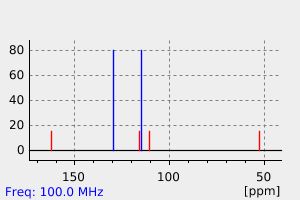p-methoxyphenylmalononitrile dimer | 140668-87-7
中文名称
——
中文别名
——
英文名称
p-methoxyphenylmalononitrile dimer
英文别名
1,2-Bis(4-methoxyphenyl)ethane-1,1,2,2-tetracarbonitrile
CAS
140668-87-7
化学式
C20H14N4O2
mdl
——
分子量
342.357
InChiKey
BIKLCXQNTNPNEP-UHFFFAOYSA-N
BEILSTEIN
——
EINECS
——
-
物化性质
-
计算性质
-
ADMET
-
安全信息
-
SDS
-
制备方法与用途
-
上下游信息
-
文献信息
-
表征谱图
-
同类化合物
-
相关功能分类
-
相关结构分类
物化性质
-
沸点:560.7±50.0 °C(Predicted)
-
密度:1.257±0.06 g/cm3(Predicted)
计算性质
-
辛醇/水分配系数(LogP):2.5
-
重原子数:26
-
可旋转键数:5
-
环数:2.0
-
sp3杂化的碳原子比例:0.2
-
拓扑面积:114
-
氢给体数:0
-
氢受体数:6
反应信息
-
作为反应物:描述:p-methoxyphenylmalononitrile dimer 以 甲苯 为溶剂, 生成参考文献:名称:取代基对空气稳定的二氰基甲基自由基热敏色素粘结强度的影响摘要:合成了一系列取代的芳基二氰基甲基自由基,并根据从可变温度电子顺磁共振和紫外可见光谱获得的van't Hoff图确定了用于自二聚的键合热力学参数。在低温下,这些自由基会二聚,但是有色的,空气稳定的自由基会在加热后返回。可以重复进行加热和冷却循环(5–95°C),而不会发生自由基降解并且具有明显的热致变色行为。我们发现哈米特之间的线性自由能关系对取代参数和二聚平衡常数,与对在具有俘获性作用之后,给电子的取代基导致键更弱,而吸电子的取代基导致键更强。密度泛函理论研究[B98D / 6-31 + G(d,p)]显示,二聚体更喜欢滑堆积的几何形状,并具有细长的键。DOI:10.1021/acs.joc.7b01188
-
作为产物:描述:2-(4-methoxyphenyl)malononitrile 在 potassium ferricyanate 作用下, 以 二氯甲烷 、 水 、 甲苯 为溶剂, 生成 p-methoxyphenylmalononitrile dimer参考文献:名称:自旋离域化、极化和伦敦色散力控制双自由基双分子基团的形成摘要:一些自由基足够稳定以被分离,但大多数要么是不稳定的瞬态物质,要么作为与二聚体形式平衡的亚稳定物质存在,通常是自旋配对 sigma 二聚体或 pi 二聚体(pimer)。为了深入了解二聚化的不同模式,我们合成并评估了一个包含 15 个芳基二氰基甲基自由基的库,以探索导致 sigma 与 pi 二聚化的结构和分子参数。我们通过变温 EPR 光谱测量每个自由基结合的强度,通过紫外-可见光谱和 X 射线晶体学确定二聚体(σ 或 pi 二聚体)的模式,并进行计算分析来评估发散二聚化行为。我们评估了三种不同的假设来解释二聚化行为的差异:(1) 二聚化行为是由自由基自旋密度决定的;(2) 它是由自由基极化率决定的;(3) 它是由二聚体的伦敦分散稳定性决定的。然而,没有单一参数模型本身是可预测的。结合计算的自旋离域度或自由基极化率以及计算的 pi 二聚体中有吸引力的伦敦色散力的估计值的双参数模型导致了对 sigmaDOI:10.1021/jacs.0c00190
文献信息
-
Direct Oxidation of Aryl Malononitriles Enabling a Copper-Catalyzed Intermolecular Alkene Carbochlorination作者:Prakash Basnet、Gang Hong、Charles E. Hendrick、Marisa C. KozlowskiDOI:10.1021/acs.orglett.0c03941日期:2021.1.15A copper-catalyzed carbochlorination of alkenes with aryl malononitriles and chloride is disclosed. This net oxidative transformation proceeds with activated and unactivated alkenes with moderate to excellent yields. Mechanism experiments suggest addition of the malononitrile radical to form a secondary carbon radical which is intercepted by a chloride source. The resultant products can be transformed
-
Copper Catalyzed Oxidative Arylation of Tertiary Carbon Centers作者:Prakash Basnet、Melissa B. Sebold、Charles E. Hendrick、Marisa C. KozlowskiDOI:10.1021/acs.orglett.0c03581日期:2020.12.18describe herein a Cu(OTf)2 catalyzed oxidative arylation of a tertiary carbon-containing substrate including aryl malononitriles, 3-aryl benzofuran-2-ones, and 3-aryl oxindoles. In some cases, the nitrile groups of the aryl malononitriles undergo further reactions leading to lactones or imines. These reaction conditions are applicable for a range of arenes, including phenols, anilines, anisoles, and heteroarenes
-
The benzene ring as a dipolarophile: Reactions of monosubstituted benzenes with tetracyanoethylene oxide作者:A. de la Hoz、C. Pardo、J. Elguero、M. L. JimenoDOI:10.1007/bf01045302日期:1992.1The reaction of tetracyanoethylene oxide on one hand and toluene, chlorobenzene, fluorobenzene, anisole, and nitrobenzene, on the other, has been studied. Toluene and the halogenobenzenes yield mixture of monoadducts, anisole yield p-methoxyphenylmalononitrile and its dimer and nitrobenzene does not react. These results are discussed with the help of a qualitative orbital model. H-1-NMR analysis of some monoadducts has been carried out.
表征谱图
-
氢谱1HNMR
-
质谱MS
-
碳谱13CNMR
-
红外IR
-
拉曼Raman
-
峰位数据
-
峰位匹配
-
表征信息
同类化合物
(E,Z)-他莫昔芬N-β-D-葡糖醛酸
(E/Z)-他莫昔芬-d5
(4S,5R)-4,5-二苯基-1,2,3-恶噻唑烷-2,2-二氧化物-3-羧酸叔丁酯
(4S,4''S,5R,5''R)-2,2''-(1-甲基亚乙基)双[4,5-二氢-4,5-二苯基恶唑]
(4R,5S)-4,5-二苯基-1,2,3-恶噻唑烷-2,2-二氧化物-3-羧酸叔丁酯
(4R,4''R,5S,5''S)-2,2''-(1-甲基亚乙基)双[4,5-二氢-4,5-二苯基恶唑]
(1R,2R)-2-(二苯基膦基)-1,2-二苯基乙胺
鼓槌石斛素
黄子囊素
高黄绿酸
顺式白藜芦醇三甲醚
顺式白藜芦醇
顺式己烯雌酚
顺式-白藜芦醇3-O-beta-D-葡糖苷酸
顺式-桑皮苷A
顺式-曲札芪苷
顺式-二苯乙烯
顺式-beta-羟基他莫昔芬
顺式-a-羟基他莫昔芬
顺式-3,4',5-三甲氧基-3'-羟基二苯乙烯
顺式-1-(3-甲基-2-萘基)-2-(2-萘基)乙烯
顺式-1,2-双(三甲基硅氧基)-1,2-双(4-溴苯基)环丙烷
顺式-1,2-二苯基环丁烷
顺-均二苯乙烯硼酸二乙醇胺酯
顺-4-硝基二苯乙烯
顺-1-异丙基-2,3-二苯基氮丙啶
非洲李(PRUNUSAFRICANA)树皮提取物
阿非昔芬
阿里可拉唑
阿那曲唑二聚体
阿托伐他汀环氧四氢呋喃
阿托伐他汀环氧乙烷杂质
阿托伐他汀环(氟苯基)钠盐杂质
阿托伐他汀环(氟苯基)烯丙基酯
阿托伐他汀杂质D
阿托伐他汀杂质94
阿托伐他汀杂质7
阿托伐他汀杂质5
阿托伐他汀内酰胺钠盐杂质
阿托伐他汀中间体M4
阿奈库碘铵
锌(II)(苯甲醛)(四苯基卟啉)
银松素
铜酸盐(5-),[m-[2-[2-[1-[4-[2-[4-[[4-[[4-[2-[4-[4-[2-[2-(羧基-kO)苯基]二氮烯基-kN1]-4,5-二氢-3-甲基-5-(羰基-kO)-1H-吡唑-1-基]-2-硫代苯基]乙烯基]-3-硫代苯基]氨基]-6-(苯基氨基)-1,3,5-三嗪-2-基]氨基]-2-硫代苯基]乙烯基]-3-硫代
铒(III) 离子载体 I
铀,二(二苯基甲酮)四碘-
钾钠2,2'-[(E)-1,2-乙烯二基]二[5-({4-苯胺基-6-[(2-羟基乙基)氨基]-1,3,5-三嗪-2-基}氨基)苯磺酸酯](1:1:1)
钠{4-[氧代(苯基)乙酰基]苯基}甲烷磺酸酯
钠;[2-甲氧基-5-[2-(3,4,5-三甲氧基苯基)乙基]苯基]硫酸盐
钠4-氨基二苯乙烯-2-磺酸酯







